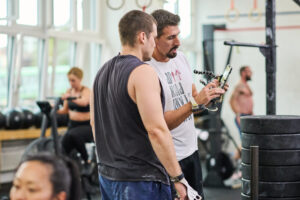
CrossFit is often recognized for its intensity, its varied workouts, and its emphasis on functional fitness. But one of the most defining aspects of CrossFit is something that often gets overlooked: movement standards. Whether it’s a squat, a pull-up, or a clean, every movement in CrossFit has a defined range of motion that athletes are expected to meet.
These standards aren’t arbitrary. They exist for a reason, and they impact everything from tracking progress to ensuring safety and maintaining fairness in competition. While many people understand the importance of safety and injury prevention, one of the less obvious—but equally critical—reasons for movement standards is measurement. Without a consistent standard, how can you know if you’re truly improving?
Let’s break down why movement standards matter, starting with the most underrated aspect—measurable progress.
Tracking progress: apples to apples
One of the biggest challenges in fitness is measuring progress accurately. Many people assume they are getting stronger just because they lift heavier weights, but without consistent movement standards, those numbers can be misleading.
Take the squat as an example. If an athlete squats 95 kg to full depth today and then squats 100 kg next month but doesn’t reach the same depth, did they actually get stronger? Or did they simply move differently? Without a clear standard for range of motion, it becomes impossible to compare one performance to another.
The same logic applies across all movements. If you’re doing push-ups, but your chest doesn’t reach the floor anymore, are you really improving? If your pull-ups don’t get your chin over the bar, can you count them as progress? Consistency is key. Movement standards ensure that every rep is performed in the same way, so improvements are real and measurable—not just an illusion created by cutting corners.
Safety: protecting your body in the long run
While measurable progress is a key reason for movement standards, safety is just as crucial. The human body is designed to move in specific ways, and skipping steps in those movement patterns can lead to long-term damage.
Returning to the squat example, when an athlete squats to full depth, they engage the glutes, hamstrings, and quads in a balanced way. If they stop short, they place more stress on their knees, which over time can contribute to joint issues and imbalances.
Other movements follow the same principle. A deadlift that doesn’t reach full hip extension limits posterior chain engagement and can lead to back strain. A press that stops short of full lockout means the shoulders aren’t stabilizing the load properly, increasing the risk of injury. Even simple movements like step-ups and lunges can become problematic if the range of motion is inconsistent.
Standards aren’t about making movements harder—they’re about keeping athletes moving well for years to come.
Fairness: a level playing field in training and competition
CrossFit is built on competition—whether that’s against yourself, your gym buddies, or the leaderboard. But competition only works if everyone is held to the same standard.
Imagine two athletes performing a workout with air squats. One goes to full depth every time, while the other barely bends their knees. If they both finish the workout in the same time, is that a fair comparison? The athlete who skipped depth completed less work, meaning their score doesn’t truly reflect equal effort.
This is why judging exists in CrossFit competitions, from local throwdowns to the CrossFit Games. Without movement standards, there would be no way to determine who performed best. But this principle shouldn’t just apply in competition—it should be upheld in everyday training. Holding yourself and others accountable to movement standards creates a culture of integrity and respect in the gym.
Efficiency: moving with purpose
Beyond safety and fairness, movement standards also exist to maximize efficiency. CrossFit is about functional fitness—training the body to perform movements that translate to real life. Cutting reps short doesn’t just change the workout; it also reduces the effectiveness of the movement itself.
Take kipping pull-ups as an example. When done correctly—with full range of motion and proper technique—they allow an athlete to complete high-rep pull-ups efficiently while still building pulling strength. But when performed sloppily—with half reps and poor control—they become ineffective and increase the risk of shoulder injuries.
Another example is the Olympic lifts. If an athlete doesn’t fully extend at the top of a clean, they lose out on power development. A wall ball shot that doesn’t hit the target doesn’t challenge the athlete the way it’s intended to. Every standard exists to ensure that the movement is done in a way that maximizes its intended benefits.
Discipline and integrity: doing things right when no one is watching
At the heart of movement standards is something bigger than fitness: discipline. The willingness to hold yourself to a standard—even when it’s tough, even when no one else is watching—is what separates those who truly progress from those who stagnate.
There’s a saying in CrossFit: “How you do anything is how you do everything.” If you cut corners in training, where else in life are you cutting corners? The best athletes aren’t the ones who chase numbers at all costs—they’re the ones who commit to doing things the right way, every single time.
Ultimately, movement standards aren’t just about CrossFit. They’re about setting expectations, holding yourself accountable, and ensuring that every rep, every set, and every workout actually means something. They’re about making sure that when you get stronger, you know it’s real strength—not just a change in movement.
So the next time you’re grinding through a workout, chasing a PR, or competing with a friend, ask yourself: am I moving the same way I did before? If not, the number on the whiteboard might not mean what you think it does. In the long run, real progress—the kind that lasts—comes from discipline, consistency, and respect for the standards that make CrossFit such an effective training method.




